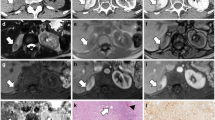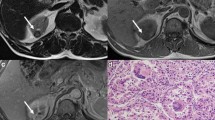Abstract
Background
Lipid-poor angiomyolipomas (lpAMLs) constitute up to 5% of renal angiomyolipomas and are challenging to differentiate from malignant renal lesions on imaging alone. This review aims to identify clinical and MRI features which can be utilized to improve specificity and diagnostic accuracy for detecting lpAMLs in patients being considered for active surveillance rather than intervention.
Findings
Young age, female sex, and small lesion size are associated with lpAMLs in studies evaluating indeterminate renal lesions. The accuracy of criteria using T2-weighted imaging, diffusion-weighted imaging, chemical shift imaging, dynamic contrast enhancement, multiparametric imaging, and radiomics are reviewed. Low T2 signal intensity is a particularly important MRI feature for lpAML. In studies with low T2 signal intensity, homogeneous early enhancement is a typical feature with an arterial-to-delay enhancement ratio > 1.5. Intratumoral hemorrhage with decrease in signal intensity on in-phase chemical shift imaging may be particularly useful for differentiating papillary renal cell carcinomas from lpAMLs in low T2 signal intensity lesions. Combining clinical and multiparametric MRI features can result in near-perfect specificity for lpAML.
Summary
In select patients, clinical and MRI features can result in a high specificity and diagnostic accuracy for lpAMLs. These lesions can be considered for active surveillance rather than invasive diagnostic and therapeutic procedures such as biopsy or surgery.

Similar content being viewed by others
References
Fittschen A, Wendlik I, Octuerk S, et al. Prevalence of sporadic renal angiomyolipoma: A retrospective analysis of 61,389 in- and out-patients. Abdom Imaging 2014;39:1009-1013.
Jinzaki M, Silverman SG, Akita H, et al. Renal angiomyolipoma: A radiological classification and update on recent developments in diagnosis and management. Abdom Imaging 2015;39:588-604.
Flum AS, Hamoui N, Said MA, et al. Update on the diagnosis and management of renal angiomyolipoma. J Urol 2016;195(4 Pt 1):834-846.
Nelson CP, Sanda MG. Contemporary diagnosis and management of renal angiomyolipoma. J Urol 2002;168(4 Pt 1):1315-1325.
Maclean DF, Sultana R, Radwan R, et al. Is the follow-up of small renal angiomyolipomas a necessary precaution? Clin Radiol 2014;68(8):822-826.
Vendrami CL, Villavicencio CP, DeJulio TJ, et al. Differentiation of solid renal tumors with multiparametric MR imaging. Radiographics 2017;37:2026-2042.
Jeong CJ, Park BK, Park JJ, et al. Unenhanced CT and MRI parameters that can be used to reliably predict fat-invisible angiomyolipoma. AJR Am J Roentgenol 2016;206:340-347.
Park JJ, Kim CK. Small (< 4 cm) renal tumors with predominantly low signal intensity on T2-weighted images: differentiation of minimal-fat angiomyolipoma from renal cell carcinoma. AJR Am J Roentgenol 2017;208:124-130.
Kang SK, Huang WC, Pandharipande PV et al. Solid renal masses: What the numbers tell us. AJR Am J Roentgenol 2014;202(6):1196-1206.
Wilson MP, Patel D, Murad MH, et al. Diagnostic performance of MRI in the detection of lipid-poor angiomyolipomas: a systematic review and meta-analysis. Radiology 2020;296(3):511-520.
Choi HJ, Kim JK, Ahn H, et al. Value of T2-weighted MR imaging in differentiating low-fat renal angiomyolipomas from other renal tumors. Acta Radiologica 2011;52:349-352.
Ding X, Chen L, Zhang H. Differentiation of low-fat renal angiomyolipomas from other renal tumors: Effect of T2-weighted MR imaging. Journal of Urology 2014;191(4Suppl):e282.
Hindman N, Ngo L, Genega EM, et al. Angiomyolipoma with minimal fat: Can it be differentiated from clear cell renal cell carcinoma by using standard MR techniques? Radiology 2012;265(2):468-477.
Lim RS, McInnes MDF, Siddaiah M, et al. Are growth patterns on MRI in small (< 4 cm) solid renal masses useful for predicting benign histology? European Radiology 2018;28:3115-3124.
Moriyama S, Yoshida S, Tanaka H, et al. Intensity ratio curve analysis of small renal masses on T2-weighted magnetic resonance imaging: Differentiation of fat-poor angiomyolipoma from renal cell carcinoma. International Journal of Urology 2018;25:554-560.
Soma T, Ishioka J, Tanaka H, et al. Potential for computer-aided diagnosis using a convolutional neural network algorithm to diagnose fat-poor angiomyolipoma in enhanced computed tomography and T2-weighted magnetic resonance imaging. Int J Urol 2018;25(11):978-979.
Tanaka H, Fujii Y, Tanaka H, et al. Stepwise algorithm using computed tomography and magnetic resonance imaging for diagnosis of fat-poor angiomyoliopma in small renal masses: Development and external validation. Int J Urol 2017;24:511-517.
Woo S, Kim SY, Cho JY, et al. Differentiation between papillary renal cell carcinoma and fat-poor angiomyolipoma: A preliminary study assessing detection of intratumoral hemorrhage with chemical shift MRI and T2*-weighted gradient echo. Acta Radiologica 2018;59(5):627-634.
Ding Y, Zeng M, Rao S, et al. Comparison of biexponential and monoexponential model of diffusion-weighted imaging for distinguishing between common renal cell carcinoma and fat poor angiomyolipoma. Korean J Radiol 2016;17(6):853-863.
Feng Q, Ma Z, Zhang S, et al. Usefulness of diffusion tensor imaging for the differentiation between low-fat angiomyolipoma and clear cell carcinoma of the kidney. SpringerPlus 2016;5(12):1-6.
Li H, Liang L, Li A, et al. Monoexponential, biexponential, and stretched exponential diffusion-weighted imaging models: Quantitative biomarkers for differentiating renal clear cell carcinoma and minimal fat angiomyolipoma. J Magn Reson Imaging 2017;46:240-247.
Li A, Xing W, Li H, et al. Subtype differentiation of small (</=4 cm) solid renal mass using volumetric histogram analysis of DWI at 3-T MRI. AJR Am J Roentgenol 2018;211:614-623.
Li H, Li A, Zhu H, et al. Whole-tumor quantitative apparent diffusion coefficient histogram and texture analysis to differentiation of minimal fat angiomyolipoma from clear cell renal cell carcinoma. Acad Radiol 2019;26:632-639.
Zhu Q, Zhu W, Ye J, et al. Value of intravoxel incoherent motion for differential diagnosis of renal tumors. Acta Radiologica 2019;60(3):382-387.
Ferre R, Cornelis F, Verkarre V, et al. Double-echo gradient chemical shift MR imaging fails to differentiate minimal fat renal angiomyolipomas from other homogenous solid renal tumors. European Journal of Radiology 2015;84:360-365.
Murray CA, Quon M, McInnes MDF, et al. Evaluation of T1-weighted MRI to detect intratumoral hemorrhage within papillary renal cell carcinoma as a feature differentiating from angiomyolipoma without visible fat. AJR Am J Roentgenol 2016;207:585-591.
Wang H, Su Z, Xu X, et al. Dynamic contrast-enhanced MRI in renal tumors: Common subtype differentiation using pharmacokinetics. Sci Rep 2017;7:3117
Cornelis F, Tricaud E, Lasserre AS, et al. Routinely performed multiparametric magnetic resonance imaging helps to differentiate common subtypes of renal tumors. Eur Radiol 2014;24:1068-1080.
Kay FU, Canvasser NE, Xi Y, et al. Diagnostic performance and interreader agreement of a standardized MR imaging approach in the prediction of small renal mass histology. Radiology 2018;287(2):543-553.
Sasiwimonphan K, Takahashi N, Leibovich BC, et al. Small (< 4 cm) renal mass: Differentiation of angiomyolipoma without visible fat from renal cell carcinoma utilizing MR imaging. Radiology 2012;263:160-169.
Schieda N, Dilauro M, Moosavi B, et al. MRI evaluation of small (< 4 cm) solid renal masses: multivariate modeling improves diagnostic accuracy of angiomyolipoma without visible fat compared to univariate analysis. Eur Radiol 2016;26:2242-2251.
Lubner, M. G. (2020). Radiomics and Artificial Intelligence for Renal Mass Characterization. Radiologic Clinics, 58(5), 995-1008.
Ursprung, S., Beer, L., Bruining, A., Woitek, R., Stewart, G. D., Gallagher, F. A., & Sala, E. (2020). Radiomics of computed tomography and magnetic resonance imaging in renal cell carcinoma—a systematic review and meta-analysis. European radiology, 1-9.
Soma, T., Ishioka, J., Tanaka, H., Matsuoka, Y., Saito, K., & Fujii, Y. (2018). Potential for computer‐aided diagnosis using a convolutional neural network algorithm to diagnose fat‐poor angiomyolipoma in enhanced computed tomography and T2‐weighted magnetic resonance imaging. International Journal of Urology, 25(11), 978-979.
Vendrami, C. L., McCarthy, R. J., Villavicencio, C. P., & Miller, F. H. (2020). Predicting common solid renal tumors using machine learning models of classification of radiologist-assessed magnetic resonance characteristics. Abdominal Radiology, 45(9), 2797-2809.
Chung MS, Choi HJ, Kim MH, et al. Comparison of T2-weighted MRI with and without fat suppression for differentiating renal angiomyolipomas without visible fat from other renal tumors. AJR Am J Roentgenol 2014;202:765-771.
Cupido BD, Sam M, Winters SD, et al. A practical imaging classification for the non-invasive differentiation of renal cell carcinoma into its main subtypes. Abdom Radiol 2017;42(3):908-917.
Funding
No funding was used for this review.
Author information
Authors and Affiliations
Contributions
All authors have contributed to the design, review, write-up and editing of this article. All authors have approved the final manuscript.
Corresponding author
Additional information
Publisher's Note
Springer Nature remains neutral with regard to jurisdictional claims in published maps and institutional affiliations.
Rights and permissions
About this article
Cite this article
Wilson, M.P., Patel, D., Katlariwala, P. et al. A review of clinical and MR imaging features of renal lipid-poor angiomyolipomas. Abdom Radiol 46, 2072–2078 (2021). https://doi.org/10.1007/s00261-020-02835-6
Received:
Revised:
Accepted:
Published:
Issue Date:
DOI: https://doi.org/10.1007/s00261-020-02835-6




